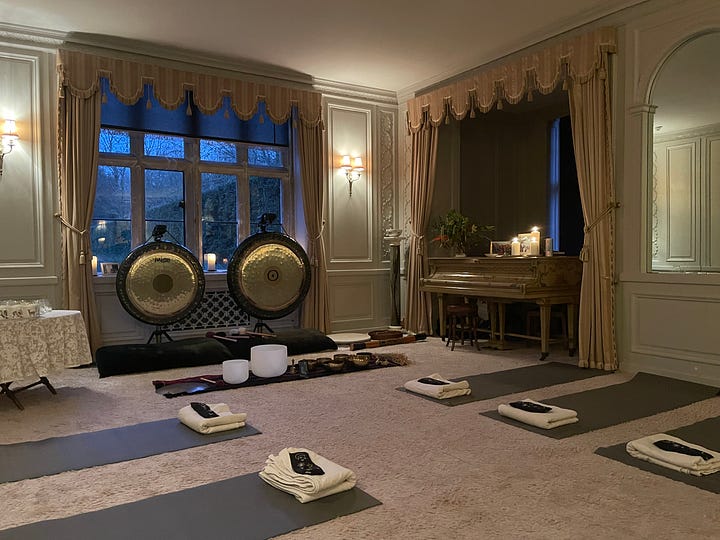Spiced Chocolate Truffle Recipe and Herbal Heart Elixirs
#5 The best chai chocolate truffle recipe, herbal winter wellness guides, and why you should practice breathing through your heart.
Priorities first - chocolate
My current obsession is herbal chai chocolate truffles. A hug in a mouthful, these silky, gently spiced beauties sing with notes of cardamom, cinnamon, ginger and black pepper. In my love of all things plants, I signed up some time ago to receive a newsletter from Chestnut School of Herbal Medicine. Over the winter they released an amazing Winter Seasonal Guide (containing said truffle recipes) that I wanted to share with you all. I trust you’ll enjoy it as much as I did.
I’ve tried the traditional and plant based versions of the truffles - both are divine. If truffles aren’t your thing, try spicing up your hot chocolate!
I’ve also made their Hawthorn and Rose Heart Elixir - of course!
If you’re curious about how herbs can support your health, I work with a wonderful Bristol based herbalist, Helen Rideout. She not only supports me personally, but some of you will recognise her from the workshop offerings at Wildling Studio. If you don’t have time to make your own, Helen offers a range of elixirs as well as opportunities to book personalised consultations - in person or via zoom.
Helen specialises in general women’s health (including menstrual disregulation, polycystic ovarian syndrome (PTOS), endometriosis, PMT, and PMDD), peri-menopause and menopause as well as thyroid conditions and other endocrine and immune related diseases.
Fluent
I would love to live
Like a river flows,
Carried by the surprise
Of its own unfolding.
- John O'DonohueDon’t forget every Sunday at 8:30pm you can join me on Zoom for twenty minutes of radiating heart!
We’re back!
Mia and I hosted our first event of the year last Thursday - which, as it happened, also turned out to be Burns night, the first full moon of the year and very close to Imbolc. An auspicious time indeed to be creating vision boards and sinking into the healing vibrations of Mia’s sonic soundscape.


Cadenham’s drawing room held us lovingly as we curled up cushioned on the fluffiest carpet I’ve ever felt, surrounded by the warm glow of candles and the sporadic crackle and hiss of wood in the fireplace. Although a familiar home to small concerts on its mesmerisingly intricate antique grand piano, this, I believe, was the drawing room’s first sound journey, and I like to think the room enjoyed it. It was a moving evening surrounded by wonderful souls crafting visions full of love, adventure and spice.
If you’d like to experience one of Mia’s sound journeys you can find out about her upcoming events on her website. She hosts regular sessions in both Avebury and Calne.

Why breathe in and out through the heart?
Ever heard the saying ‘ where attention goes, energy flows?’
“While the heart is certainly a remarkable pump, interestingly, it is only relatively recently in the course of human history—around the past three centuries or so—that the heart’s function has been defined (by Western scientific thought) as only that of pumping blood. Historically, in almost every culture of the world, the heart was ascribed a far more multifaceted role in the human system, being regarded as a source of wisdom, spiritual insight, thought, and emotion. Intriguingly, scientific research over the past several decades has begun to provide evidence that many of these long-surviving associations may well be more than simply metaphorical. “
By inhaling and exhaling through our heart during heart focused breathing, we bring our heart rhythm into a coherent state, and cultivate our ability to access our ‘intelligent heart’. Yes, I’ve just mentioned the word heart four times in one sentence - you get the idea, it’s important (or, just bad writing!)
If any of you, like me, grew up with ‘Dirty Dancing’ as a staple part of your childhood, it would only be natural to think of your heart’s rhythm as a steady metronome. Cue the memorable swoon worthy (or cringe worthy depending on your disposition,) scene where Johnny places Baby’s hand on his heart as they’re practising their performance dance and says, “It’s a feeling, a heartbeat”.
However, rather than a steady ‘ga-gung, ga-gung’ as Johnny would say, the rhythm of a healthy heart - even under resting conditions - is surprisingly irregular. The time between each beat of our heart is constantly changing and this naturally occurring beat-to-beat variation is called heart rate variability (HRV).
This next bit is a little more technical - so take your time.
The variability in our heart rate is caused by the two branches of our autonomic nervous system. Our autonomic nervous system controls the majority of our body’s internal functions without us having to consciously think about them - eg. breathing, digestion, blood pressure and heart rate. Our autonomic nervous system has two branches: sympathetic and parasympathetic.
Sympathetic nerves act to accelerate our heart rate.
Parasympathetic (vagus) nerves act to slow down our heart rate.
The sympathetic and parasympathetic branches of our autonomic nervous system continually interact to maintain an optimal range in our cardiovascular activity. When we measure and analyse our heart rate variability, we have a dynamic window into the function and balance of our autonomic nervous system.
“Scientists and physicians consider HRV to be an important indicator of health and fitness. As a marker of physiological resilience and behavioural flexibility, it reflects our ability to adapt effectively to stress and environmental demands. A simply analogy helps to illustrate this point: just as the shifting stance of a tennis player about to receive a serve may facilitate swift adaptation, in healthy individuals the heart remains similarly responsive and resilient, primed and ready to act when needed,”
Heart Rhythm Patterns and our Emotions - Our mental and emotional health is deeply connected with our physical wellbeing.
Lots of factors affect our autonomic nervous system and therefore influence our heart rate variability including our breathing patterns, physical activity and even our thoughts.
Research at the HeartMath Institute has shown that one of the most powerful factors that affects our heart’s changing rhythm is our feelings and emotions. In general, emotional stress - including emotions such as anger, frustration and anxiety produce heart rhythm patterns that appear irregular and erratic. Likewise, stressful emotions create physiological wear and tear on our whole body.
In contrast, when we experience uplifting emotions such as appreciation, care, joy and love, our heart rhythm patterns become highly ordered and coherent.
HeartMath techniques encourage us to build a coherent heart rhythm and increase our overall baseline of coherence - often by activating regenerative emotions. Coherence is a state that supports our body’s natural regenerative process. It can help transform stress and anxiety, facilitate higher cognitive function and support our ability to regulate our emotions. We overall develop better discernment, clearer perspectives, increased creativity, intuition and resourcefulness. Quite the package deal if you ask me.
The power of breathing through the heart and activating regenerative emotions in these coherence tools, not only provides in-the-moment benefits, but over time facilitates sustained changes in our health. Our bodies become increasingly familiar with a new operating system and we can start to shift to a more balanced ‘normal’.
Curios about more heart based science? Check out this article.
Looking to start your practice? Start by joining me for a Heart Lock-In every Sunday on zoom. It’s a free session, starts at 8:30pm and lasts for about 20 minutes.
With much, much love and a little spice,
Camille






